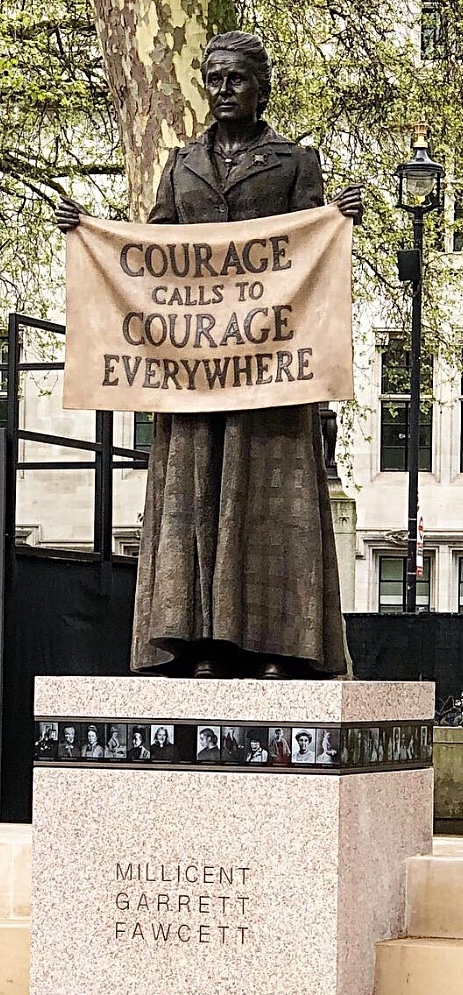
Millicent Fawcett
In April 2018 history was made by a statue of a woman – suffragist Millicent Fawcett – being unveiled in London’s iconic Parliament Square, joining the oldest gentlemen’s club (11 men and no women) in the country.
The statue, by Gillian Wearing, marks the anniversary of 100 years of women’s suffrage, when the first women got the vote after years of campaigning by suffragists and suffragettes. Unlike her male colleagues Millicent’s plinth displays images of others who were active in the fight for votes for women – acknowledging the collaborative effort.
Another great aspect of this project, instigated by feminist campigner Caroline Criado Perez, and backed by Mayor of London, Sadiq Khan, is that the whole process – from petition to project manager – has been made up of solely women.“That should make us all incredibly proud,” Mr Khan said. “So the questions can’t be asked now: Are there any talented women sculptors? Are there any talented women project managers? Are there any talented women with ideas? We have thrown those questions out the window.”
Gillian Wearing’s clever use of a hand written placard referencing the death of Emily Wilding Davidson, a suffragette who, unlike suffragist Millicent, espoused direct action, brings the 2 wings of the movement together in this one figure. It also makes it feel contemporary, as if she could have been with us on the Women’s March, bringing her protest into the present, where women are still campaigning for our rights.
100 years of Women’s Suffrage
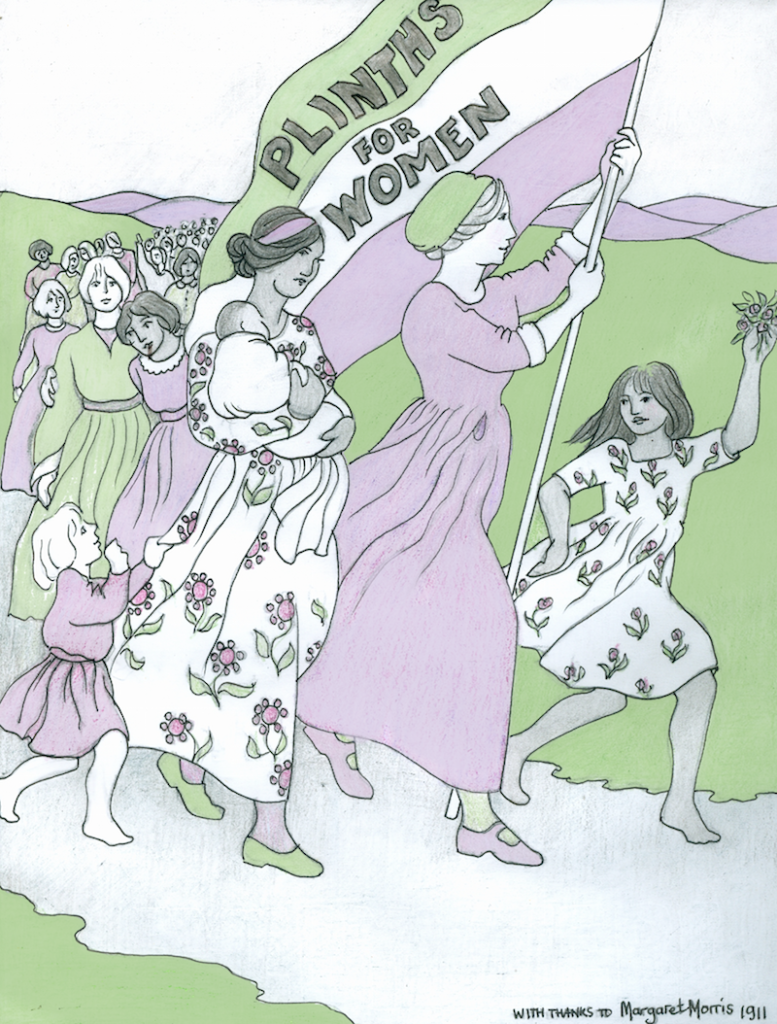
This year we celebrate 100 years since some women got the vote but there is still a long way to go to real gender equality. Now women are increasingly staking a claim in how we are presented, in who it is we choose to “look up to” on our civic plinths, and that is not always the “Great and the Good” sometimes it is the wonderful everyday women, the workers.
Cracker Packers
Hazel Reeve’s Cracker Packers were unveiled in March in Carlisle. The lively bronze statue celebrates the long history of women workers at the biscuit factory with two women – one from past times and one from the modern day – dressed in their respective factory uniforms.
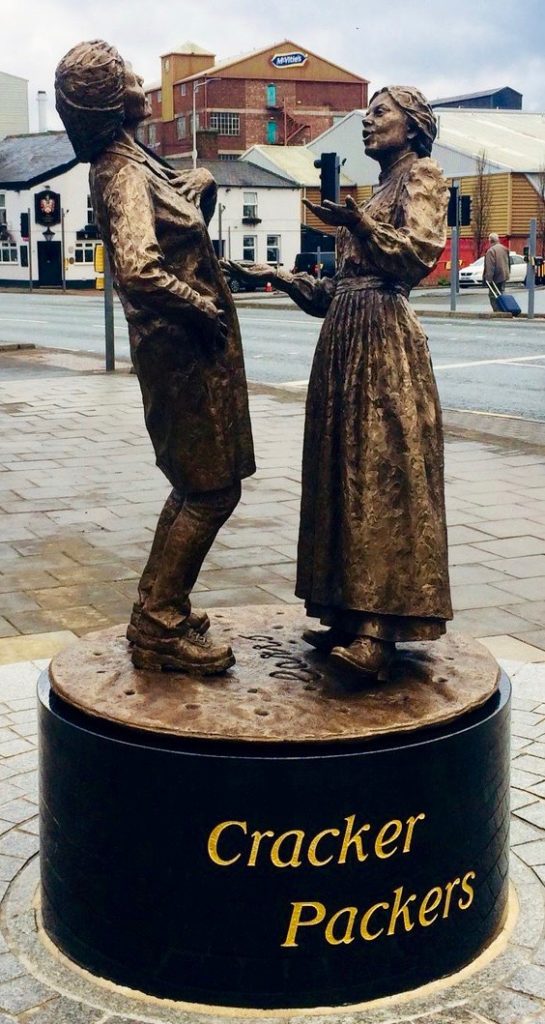
It is all too easy to imagine that there is no funding for statues to women but this, and others recently erected, belies that idea. Here’s Hazel ( bottom left ) with some of today’s Cracker Packers.

Getting Attention
The changing attitude to who we commemorate comes in a year that has seen the amazing ‘Me Too‘ and ‘Time’s Up‘ mass movements against male aggression, and the idea of fairer representation of women has been getting media attention like never before. The tide is turning, the world is waking up – being made to wake up – to the reality of women’s contributions to society – for centuries rendered invisible – and finally beginning to redress the callous attitudes of the past, and provide memorials that befit those contributions.
Alice Hawkins
The life and work of Suffragette Alice Hawkins, was honoured in Leicester this February. This remarkable women was jailed five times for her part in the Suffragette movement and when she died was buried in a pauper’s grave.
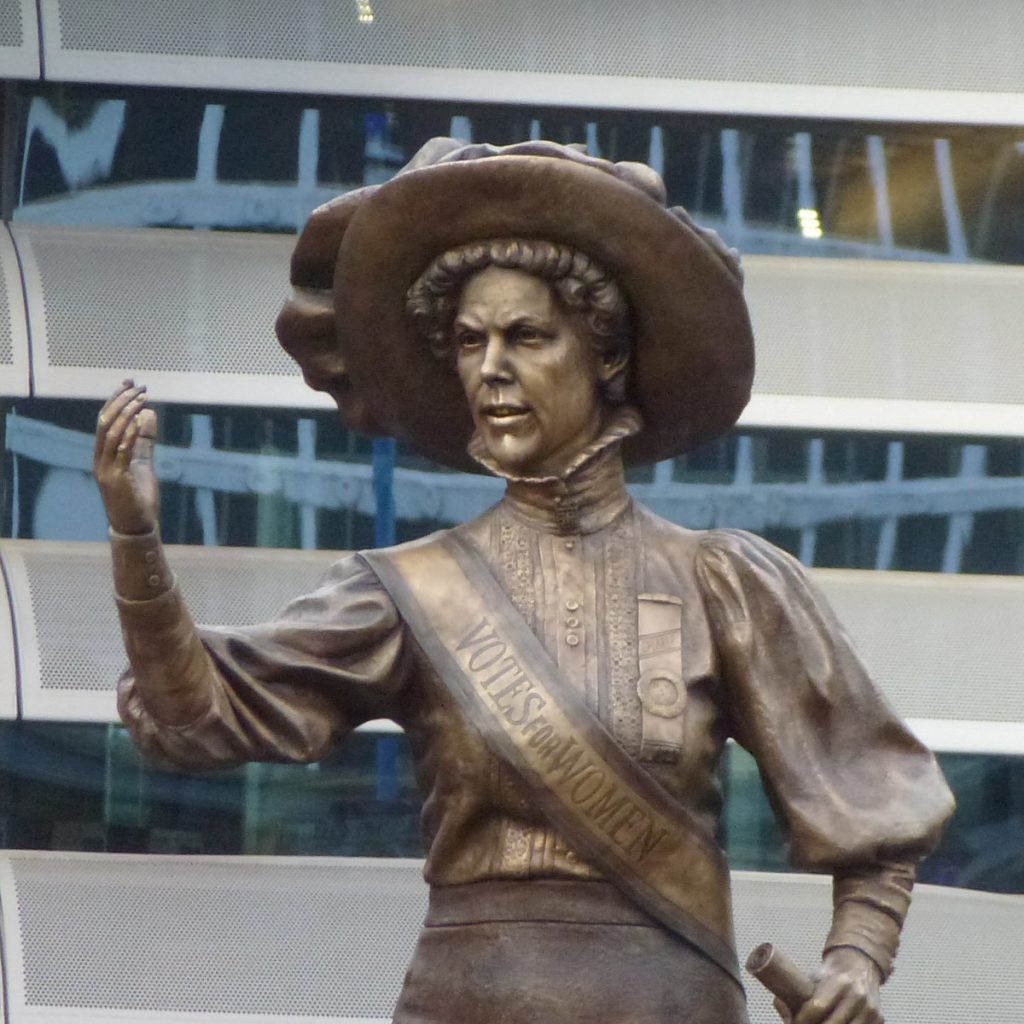
Ms Hawkins, a shoe machinist, helped lead the suffrage campaign in Leicester despite harsh treatment. As well as her work in Leicester she gave speeches in London and has finally been acknowledged for her brave struggle for the enfranchisement of women. The sculpture was funded by an anonymous donor – a city businessman – who gave the £80,000 needed for a monument.
Plinths for Women
“We cannot be what we cannot see” so women and girls are consistently shown images of men – usually old white men – chosen as worthy of looking up to and rarely see any useful role models of what or who they could become. Time for this dog-in-the-manger attitude to change. Time for more plinths for women.
Mary Barbour
Mary Barbour led the rent strikes in Glasgow in 1915 after property owners cruelly raised rent for workers, thousands of whom had flocked to the city to work in munitions factories and shipyards as part of the war effort.
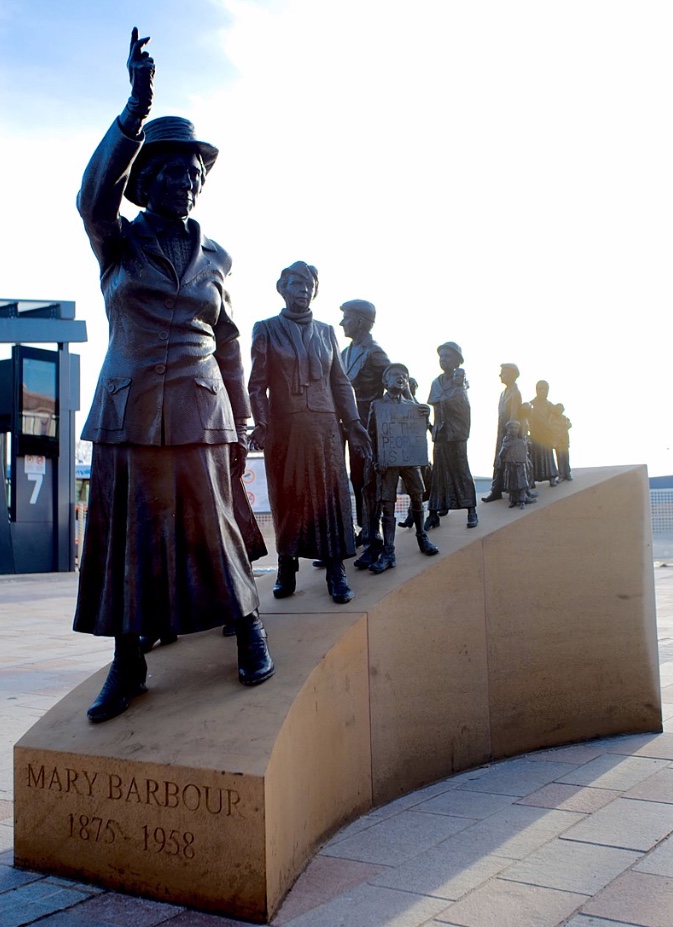
The protests forced a change in the law with the introduction of the Rent Restrictions Act. The sculpture, by Andrew Brown, was unveiled in March this year, shows her leading rent strikers who were dubbed “Mrs Barbour’s Army”.
Coming Next Year – Emmeline Pankhurst
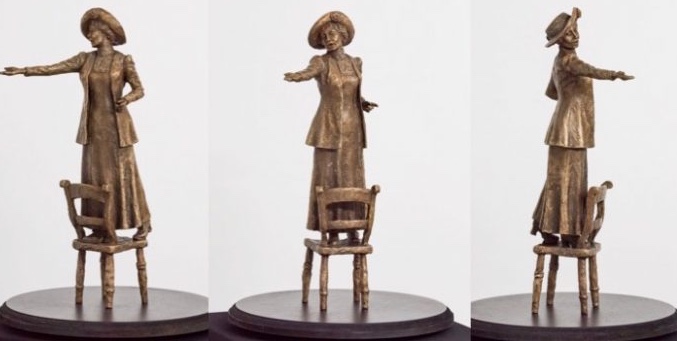
Manchester will finally honour its famous daughter, Emmeline Pankhurst, with this first statue of a woman to be erected there in 100 years. These images of the maquette for the work, by Hazel Reeve, show her as a down to earth campaigner reaching out to her audience. Look out for the unveiling in 2019.
New Campaigns
Virginia Woolf, Richmond-on-Thames
A new campaign has been launched to commission, fund and erect a statue of Virginia Woolf in Richmond-on-Thames where she lived from 1914 to 1924.
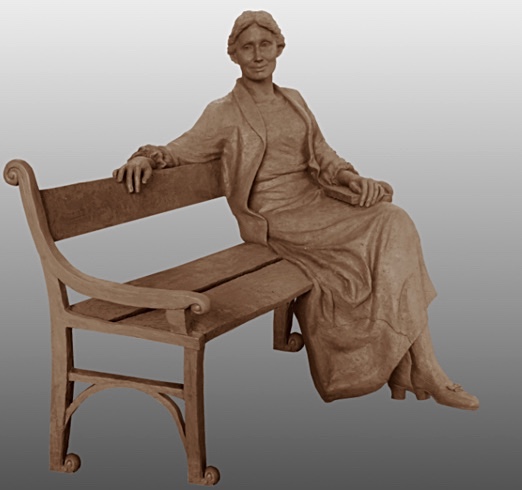
This statue will be the first ever full, life-size bronze depiction of Virginia Woolf. Imagine having your picture taken alongside this ground-breaking author.The fund raising target is £50,000.
For latest camapign news see facebook VirginiaWoolfStatue
http://www.invisiblewomen.org.uk/gettingattention/post/74
New Campaigns – Elsie Inglis, Edinburgh
Edinburgh has the dubious distinction of not only being very plentifully supplied with statues of their male heroes ( about 50 at the last count ) but also of having more monuments to animals ( 5 ) than to women ( just 2, one of which is on the outskirts of the city ). There is now a campaign for a statue to Elsie Inglis a renowned suffragette and Founder of the Scottish Women’s Hospitals.
Here’s the team from Mercat Tours in February this year during the Audacious Women Festival, campaigning for a statue to Elsie Inglis, who is surely more worthy of a memorial than a bear from the zoo famed for getting drunk on beer!
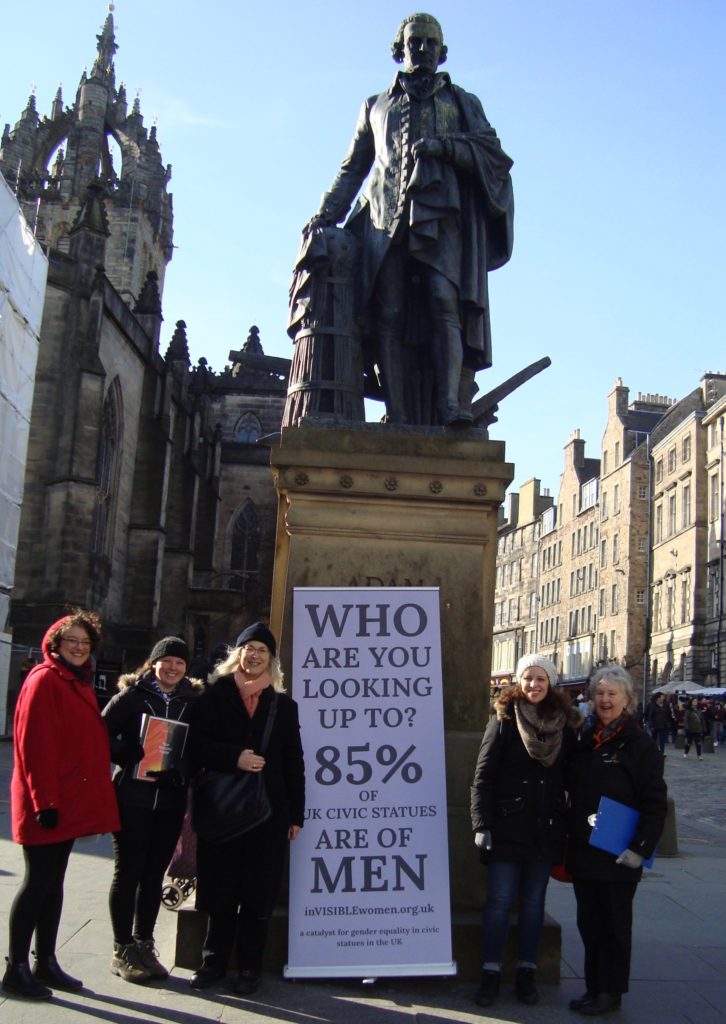
Follow this link to see a short video describing Elsie Inglis’ very impressive achievements as a suffragette and pioneering doctor.
New Campaigns – Sarah Chapman, East London
A campaign for a memorial to Sarah Chapman is underway. She was one of the leaders of the Match Girls strike at the Bryant and May match factory in Bow, East London. Sarah is ringed in red in this photo.

The Match Girls’ strike is credited with sparking a social revolution, changing working conditions across Britain. It came about because of the ‘white slavery’ practised by the factory owners Bryant & May, who paid their workers ‘starvation wages’.
For information about the campaign klick here.
More Campaigns – Sylvia Pankhurst
A bit of controversy about this one.The Women’s Vote Centenary Fund has refused to donate towards the £70,000 statue of the militant suffragette planned in the MP’s Islington South and Finsbury constituency. City of London Corporation bankers will contribute £10,000 for the Clerkenwell Green monument to the socialist activist yet there’ll be nothing from the £1.5m government pot celebrating 100 years of female enfranchisement.
Sylvia’s Conservative mother Emmeline and sister Christabel share a memorial in Westminster’s Victoria Tower Gardens. Emmeline is to have her statue in Manchester in 2019 and safe suffragist Millicent Fawcett has finally been honoured with a statue in Parliament Square. But the establishment seems to be pretending that radical Sylvia Pankhurst, an opponent of the First World War and an anti-colonial campaigner, granted a state funeral when she died in Ethiopia in 1960, never existed.
Read more here or here or here or here.
Mary Wollstonecraft
Called the ‘mother of feminism’ she wrote “A Vindication of the Rights of Women” (1792), setting out her case for equal rights for women, based on their equal power of reason. It could be argued that all women who have the belief in their power to make an impact on the way this country is run will, in some measure, have benefited from the work of Mary Wollstonecraft. The campaign “Mary on the Green” is for a statue to her on Newington Green in London where she lived and worked.
More Campaigns – Ellen Wilkinson
Middlesborough has seven statues of men and the campaign for a statue to a woman is known as “The Eighth Plinth” and Ellen Wilkinson is the people’s choice. Known as ‘Red Ellen’ she improved the Pension Bill for widows and became the first female Education Secretary, introducing free milk and school meals.
She represented Jarrow and was amongst the leaders of the Hunger Marches.
The Eighth Plinth campaign, led by Emma Chesworth, has the support of Middlesbrough Council and Middlesbrough MP Andy McDonald who said: “This is a brilliant initiative. It has always been ridiculous that 50% of the population were given less credence and paid less attention simply because of their gender.
“History is full of “her” stories and we should tell them loud and proud.”
Read more here, here, here, and here.
More Campaigns – Victoria Wood.
The writer, comedian and actor who looked at life with a wry smile and made us laugh. Manchester has plans for a tribute to her which will doubtless be much loved.
More Campaigns – Leeds
Leeds has the dubious distinction of an effigy of a warlike Black Prince
backed by 4 worthy Victorian gentlemen
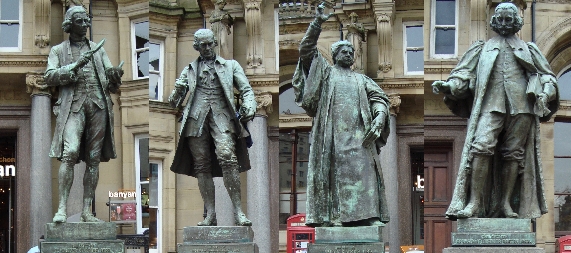
and the women? Eight nameless naked nymphs, holding up street lights.

Not surprising then that plans are afoot for some statues to women. Suggestions made so far include pioneering fundraisers Jane Tomlinson and Sue Ryder, suffragist Isabella Ford and sportswomen Beryl Burton and Nicola Adams. Politicians such as the late Jo Cox and Alice Bacon and the founder of the Leeds International Piano Competition, Dame Fanny Waterman, have also been named.
Two Statues for Wales
This image of an unknown woman is neatly symbolic of all the women we do not know about, whose histories have been hidden. Happily, the Welsh Government has £300k to mark the Centenary of Women’s Suffrage. Communities across Wales will be able to bid for grants for events to celebrate the achievements of women.
In the Autumn, the public will be able to vote to choose the Welsh women who they believe have been most inspirational. Two statues will be commissioned as a result of this project.
The Waiting List
There are so many women and women’s groups that deserve to be commemorated with dozens in the Waiting List on inVISIBLEwomen and here are a few suggested by Caroline Criado Perez in the Observer in April this year. Please feel free to add your suggestions to Waiting List on the site.
Why do we need statues of women?
We all know how powerful an image can be – it can reach our emotions so much faster than words – and a 3 dimensional image even more so. Statues “speak” to us. And if, beyond that level of communication, sites of commemoration ‘gain potentially mythic powers’, as is suggested by historians ( see post 79 ) it’s vital that, alongside the men, women from all walks of life are shown as real individuals with actual achievements – not just as nameless naked nymphs, allegorical angels or represented by empty outfits, hung up on a peg once the men return from war, as in the London memorial to women who served in WW2, which has no women in it. Frankly, this represents women as the contents of a wardrobe.
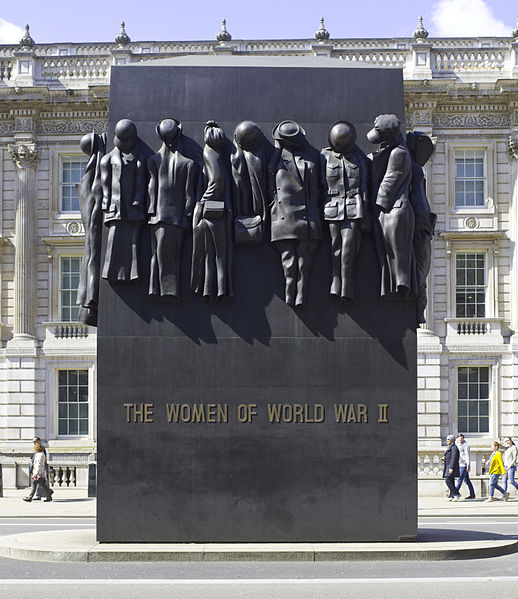
Women’s achievements, so often attained despite historic prejudice and misogyny, are easily as worthy of commemoration as those of men. If there has been this historic opposition to memorials of women, the question arises “What is it that men are afraid of?” since it has been men – the patriarchy – that have in the past, and in many cases, still nowadays hold the purse strings and the power over which monuments are erected.
Civic statues are the original subliminal ad-campaign for the patriarchy and more plinths for women are part of the UK’s progress towards equality.
Interestingly, now that a few women are beginning to be commemorated with statues in the UK we see in the press claims that Britain has too many statues. Odd that this was never noticed before while the 85% of statues that are of men were being erected.
The Power of the Civic Statue

The San Franciso monument to “Comfort Women”
Last year, Osaka terminated its 60-year sister-city ties with San Francisco in protest over a statue commemorating Asian sex slaves (so-called “comfort women”) that was erected by California’s Korean, Chinese and Filipino communities. Again, we see the power of permanent tributes to the lives of women. Even national governments recognise the capacity to reach people with a 3 dimensional representation of past deeds and mis-deeds.
Read more here, here, and here.
Funding
Even though the naysayers have long maintained that there is no money for memorials to women this is obviously not the case. The sources of funding for statues of women range from families financing a memorial, anonymous donations from business people, through crowd funding via sites like Just Giving or Virgin Money, to the state grant scheme.
The negative attitude towards funding possibilities is the same one that came up with the concept of “statue saturation” when a second statue of a woman was proposed for Parliament Square after the memorial to Millicent Fawcett had been agreed. Good heavens! TWO women amongst the the old boys club of eleven men? What would that do to the status quo? Anyone would think that women were 50% of the population!
WOW 2018
Great to have the support of Jude Kelly, Artistic Director of the Southbank Centre and founder of the wonderful WOW – Women of the World Festival – in London this March for International Women’s Day.
It was so good to meet so many engaged and positive people over the 3 days at WOW. Hope to see you again next year to celebrate even greater progress!
With thanks to Webmaestra Ffion Atkinson, WOW collaboratrice Lee Comer and Roving Reporters Anne French and Ruth Swirsky for spotting the latest news.
And if any of you would like to become ‘Roving Reporters’ and have news you would like to see on inVISIBLEwomen do send it in via the contact form on the site.
